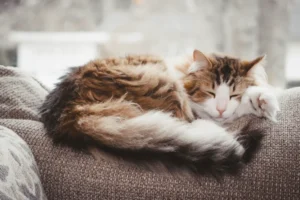Cats have always held an air of mystery around them, with their aloof nature and enigmatic behaviors. One question that many cat owners may ponder is why these feline companions only seem to talk to humans. Is there a reason behind their selective communication? Let’s explore the fascinating world of feline communication and unravel the mystery behind why cats choose to converse with humans.
The Evolution of Feline Communication
Cats have come a long way in their communication with humans. Through thousands of years of evolution, they have developed unique ways to interact with us. Back in ancient times, cats were solitary hunters, relying on their silent stalking skills to catch prey. Over time, as they began living alongside humans, their communication methods evolved to include vocalizations like meowing, purring, and hissing. This adaptation allowed them to effectively convey their needs and emotions to us, forming a deeper bond with their human counterparts.
Understanding Body Language
When it comes to decoding your feline friend’s messages, paying attention to their body language is key. From the flick of a tail to the position of their ears, cats use subtle cues to express how they’re feeling. A cat with flattened ears and a twitching tail may be agitated or fearful, while a cat with relaxed posture and slow blinking eyes is likely content and relaxed. By observing and understanding these signs, you can better communicate with your cat and strengthen your bond with them.
- Tail Position: A cat’s tail position can convey a lot about their mood. A raised tail indicates happiness or confidence, while a tucked tail suggests fear or submission.
- Ear Movement: Cats’ ears are highly expressive. Forward-facing ears show curiosity or excitement, while flattened ears indicate aggression or fear.
- Purring: Contrary to popular belief, cats don’t always purr when they’re happy. They may also purr when anxious or in pain, so it’s essential to consider the context when interpreting this vocalization.
For more in-depth insights into feline behavior, you can check out this helpful resource on cat body language: Understanding Feline Communication
Vocalizations and Their Meanings
Cats have a wide range of vocalizations, each serving a specific purpose in their communication with humans. Meowing is typically used by cats to get attention or express their needs, such as hunger or wanting to play. Purring often signifies contentment and relaxation, although it can also be a sign of distress. Hissing and growling indicate fear or aggression, warning you to back off. Chirping is a unique sound that cats make when they’re excited or showing interest in something, like birds outside a window. By paying attention to these different sounds, you can better understand your feline friend’s emotions and respond appropriately to their needs.
Bonding with Your Feline Friend
To deepen your bond with your cat, focus on building trust through meaningful communication. Spend quality time talking to your cat in a soothing tone, using their name frequently to establish a connection. Engage in interactive play sessions to strengthen your relationship and provide mental stimulation for your furry companion. Grooming your cat not only helps maintain their coat but also fosters closeness and trust between the two of you. Additionally, create a cozy environment with cozy beds and hiding spots where your cat feels safe and secure. By nurturing this bond through communication and care, you’ll create a strong and lasting connection with your feline friend.
Unique Insight:
Beyond vocalizations, cats also communicate through body language. Pay attention to your cat’s posture, tail movements, and eye contact to understand how they’re feeling. For example, a slow blink from your cat is a sign of affection and trust, while flattened ears indicate fear or aggression. By observing and responding to your cat’s body language cues, you can enhance your communication and strengthen your bond with your feline friend.
Key Tip: When engaging with your cat, remember that patience and understanding are key. Each cat is unique in their communication style, so take the time to learn and adapt to your furry friend’s preferences for meaningful interactions.
Benefits of Talking to Your Cat
Having conversations with your feline friend can strengthen the bond between you and your cat. Communication is essential in any relationship, including the one you have with your pet. When you talk to your cat, they feel more connected to you and understand your emotions better. This can lead to a deeper mutual understanding and affection.
Engaging in dialogue with your cat can also have positive effects on your cat’s mental stimulation. Talking to your cat can alleviate their boredom and increase their stimulation, leading to a happier and healthier pet. So, next time you’re hanging out with your furry friend, don’t hesitate to strike up a conversation!
Unique Insight: Talking to your cat can also help you become more attuned to their body language and vocalizations, allowing you to respond better to their needs and emotions.
Creating a Dialogue
Initiating a dialogue with your cat is easier than you might think. Begin by using a soft and soothing tone when you speak to them. Cats respond well to gentle sounds and tones. Avoid being too loud or aggressive as this can scare your cat.
Another tip is to observe your cat’s reactions when you speak to them. Do they seem interested or relaxed? Tail movements, ear positions, and eye contact can give you clues to how your cat is feeling. Respond to their reactions and emotions, creating a meaningful dialogue between the two of you.
To maintain a dialogue, make talking to your cat a regular part of your routine. Incorporate conversations into your playtime and cuddle sessions. This way, you’ll strengthen your bond and create a lasting connection with your furry companion.
Additional Tip: Experiment with different vocal tones and phrases to see how your cat responds. They may have preferences for certain sounds or words, adding a fun and interactive element to your conversations.
Fun Facts About Feline Communication
Did you know that cats have a wide range of vocalizations, from meows to purrs to chirps? Each sound serves a different purpose in their communication with humans and other animals. Cats often meow at humans because they have learned that it’s an effective way to get our attention. They may not meow as much to communicate with other cats because they rely more on body language and scents to convey messages. Understanding these unique vocalizations can deepen your bond with your feline friend and enhance your communication with them.
The Power of Non-Verbal Communication
Cats communicate not only through meows and purrs but also through subtle body language cues. Tail position is a crucial indicator of a cat’s mood; a relaxed tail usually signifies a content kitty, while an upright or fluffed tail may indicate agitation or fear. Eye contact is another important form of non-verbal communication in the feline world. Slow blinks from your cat are a sign of trust and affection. By paying attention to these non-verbal cues, you can better understand your cat’s emotions and strengthen your relationship with them.
Fun Fact: When a cat brings you a “gift” like a dead mouse or bird, it’s not just a gruesome present – it’s actually a sign of trust and a display of their hunting prowess. Cats see their humans as part of their family and are sharing their catch with you as a token of their bond.
Cultivating a Deeper Connection
Do you ever wonder why cats seem to only talk to humans? It’s not that they can’t communicate with each other, but our feline friends have a unique bond with us that encourages them to communicate more. To deepen this connection, make sure to spend quality time with your cat. Engage in playtime, grooming sessions, and simply sitting together. By actively engaging with your cat, you are showing them that you care, which can lead to more meaningful interactions.
Additionally, pay attention to your cat’s body language and vocal cues. Cats have a variety of sounds they use to communicate with us, from meows to purrs and even chirps. By being attentive to these cues, you can better understand what your cat is trying to convey. Responding to their vocalizations with your own voice can also strengthen your bond and lead to more conversations with your furry companion.
Remember, communication with your cat is a two-way street. Be patient, empathetic, and open to their needs. By actively listening and responding to your cat’s cues, you can cultivate a deeper connection that goes beyond words. So, next time your cat “talks” to you, listen carefully and respond in kind to strengthen your special bond.
The Joy of Cat Conversations
Have you ever experienced the joy of engaging in conversations with your cat? While they may not speak our language, cats have a unique way of communicating with us that can be incredibly fulfilling. By actively participating in these interactions, you can unlock a world of mutual understanding and connection with your feline friend.
One of the most rewarding aspects of cat conversations is the sense of companionship and comfort they provide. Whether your cat is meowing for attention, purring contentedly, or chirping happily, each sound carries meaning and can help you better understand your cat’s emotions and needs. By responding to these cues with your own voice and gentle touch, you can create a harmonious dialogue that strengthens your bond.
So, the next time your cat initiates a conversation, embrace the moment and engage wholeheartedly. Celebrate the joy of communicating with your feline friend and revel in the deep connection that comes from understanding each other’s unique language of love.
Key Insight: Cats may prefer talking to humans because they have learned that we are responsive and attentive to their needs. By actively listening and engaging with your cat, you can foster a strong emotional connection that transcends words.
Alex, a passionate animal lover, has experience in training and understanding animal behavior. As a proud pet parent to two dogs and three cats, he founded AnimalReport.net to share insights from animal experts and expand his knowledge of the animal kingdom.









